If, like me, you suffer from motion sickness, then you know just how quickly a trip down Britain’s winding back roads can turn into a nausea-inducing nightmare.
But if you struggle to hold on to your lunch as the car starts to lurch, there may soon be a solution.
ClearMotion, a Boston-based startup, claims that its latest generation of cutting-edge suspension can ‘eliminate motion sickness’ for good.
So, with anti-nausea tablets in hand, MailOnline’s reporter, Wiliam Hunter, took a trip to their Warwickshire testing facility to try it for himself.
Installed in the luxury NIO ET9, ClearMotion’s suspension acts like a pair of noise-cancelling headphones for the road.
With compact motors tucked away above each wheel and a sophisticated onboard computer, the system can push and pull the wheels to cancel out bumps in the road.
In theory, that should mean all the swaying and shaking that normally triggers a bout of motion sickness should be removed.
And, after a few hours of putting this system through its paces, the future of driving looks like it’s going to be a lot more comfortable.
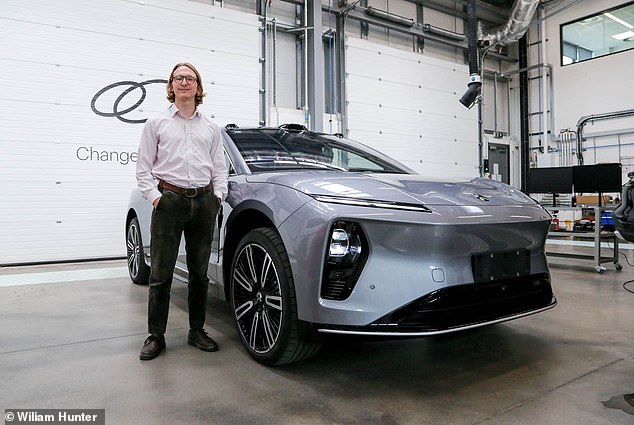
MailOnline’s Wiliam Hunter took a spin in the world’s first anti-sickness car to see if it really could spell the end for motion sickness
How does it work?
Unlike the suspension in almost every other car, the ClearMotion suspension system is ‘active’.
Normal gas and spring-based systems are passive, which means they simply place a buffer between the wheels and the body of the car to dampen the motion.
But, no matter how good a passive system might be, it can never completely negate that motion because the spring can’t compress and expand fast enough.
Active solutions get around this problem by adding outside power to the suspension system.
With ClearMotion, when the wheels start to feel an obstacle, such as a speed bump, the compact motors rapidly pull the wheels up so that this movement isn’t transferred up to the passengers.
This is what ClearMotion CEO Christian Steinmann calls the ‘sky hook’ approach; the body stays perfectly level while the wheels pump up and down to follow the contours of the road.
Drivers can even tailor their performance on the go, dialling in a stiffer sporty feel or cancelling out as much motion as possible.
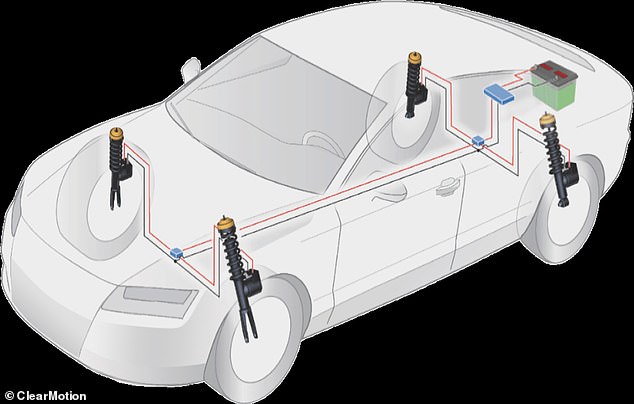
To reduce car-sickness, ClearMotion replaces the traditional shock absorbers with small, fast-acting actuators that drive the wheels up and down
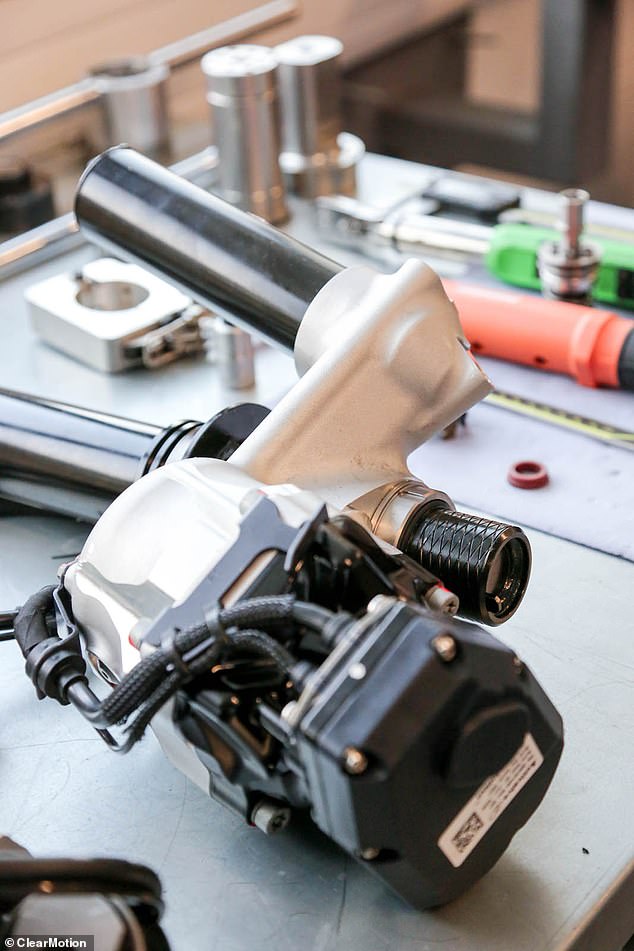
Each wheel is fitted with a ClearMotion active suspension system (pictured), which contains a compact motor, a hydraulic valve, and a computer to control the motion
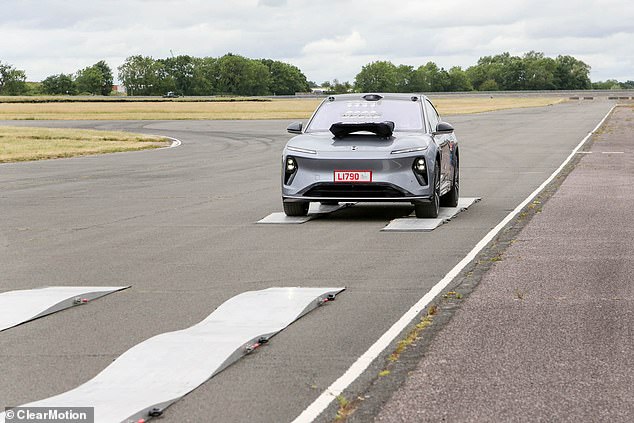
The resulting drive is so smooth that the NIO ET9, the only car currently fitted with the system, has an option called ‘Champagne Mode’ so you can drive over speed bumps with a tower of glasses on the bonnet
The result is a drive so smooth that the NIO ET9 even has an option called ‘Champagne Mode’.
As long as you don’t exceed about 12mph (20km/h), this allows you to drive over speed bumps with a tower of champagne glasses on the bonnet – in case that was something you were planning on doing.
How does it feel?
Over the course of the afternoon, we put the NIO ET9 equipped with ClearMotion’s suspension to the test on everything from winding back roads to a specially designed vehicle test track.
After spending the morning learning about the tech, I was excited to feel just how velvety smooth the ride could be.
But as we raced along a B road, I was almost a little disappointed.
The ride was certainly exceptionally smooth, but there were still a few rumbles and shakes rather than the maglev-like experience I’d been expecting.
But then our host suggested turning the active system off for a moment so I could really feel the difference.
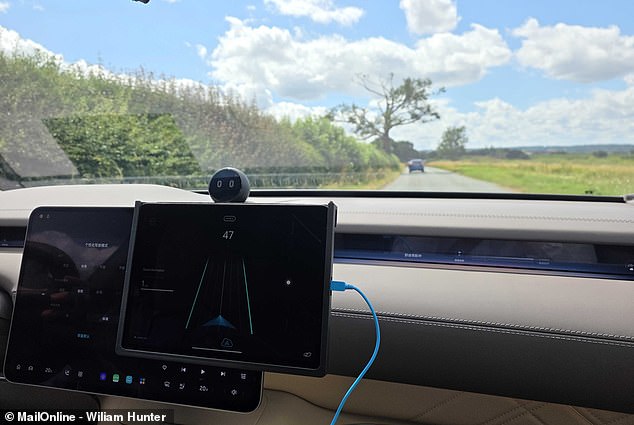
Out on the roads, ClearMotion made even the most pothole-ridden backroads feel exceptionally smooth and comfortable
Suddenly, we were bumping and lurching and rolling around like a ship on a stormy sea.
Lumps and divots I had been blissfully ignorant of suddenly seemed to appear out of nowhere.
Whereas before I had been blithely making notes on my experience, I could now hardly touch pen to page before being jolted into an illegible scribble.
Now I realised just how bad this pothole-ridden track really was, and just how good ClearMotion’s system had been.
With relief, we switched the active system back on, and it was like floating on a cloud by comparison.
Looking at the road ahead, I could see other cars lurching and swaying over the contours of the road while ours remained almost perfectly still.
I could still feel the movement of the car and the connection to the road, but it was as if the volume had been turned down from a roar to a murmur.
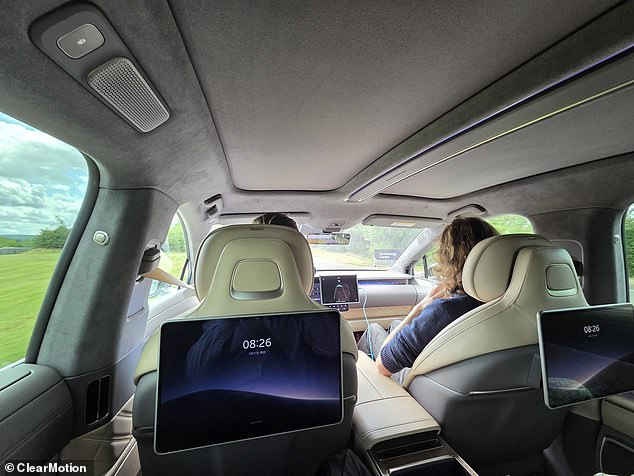
Even sitting in the back seats and trying to read, there was none of the motion sickness that this would typically produce
Could it be better?
Of course, even the best active system can’t create the perfect ride if it’s just being reactive.
Marco Giovanardi, ClearMotion Technical Fellow, told MailOnline: ‘It is like a blind man feeling his way down the road. You can be quick to respond, but you’re always responding in the moment.’
This becomes a problem when the road contains obstacles which are bigger than what the suspension system can absorb.
When the car starts going over an obstacle, it doesn’t know whether this is a small bump it can quickly move over or the start of a steep bridge it needs to take slowly.
That means any active system will still need to make compromises with its range of motion, so the ride isn’t as good as it could be
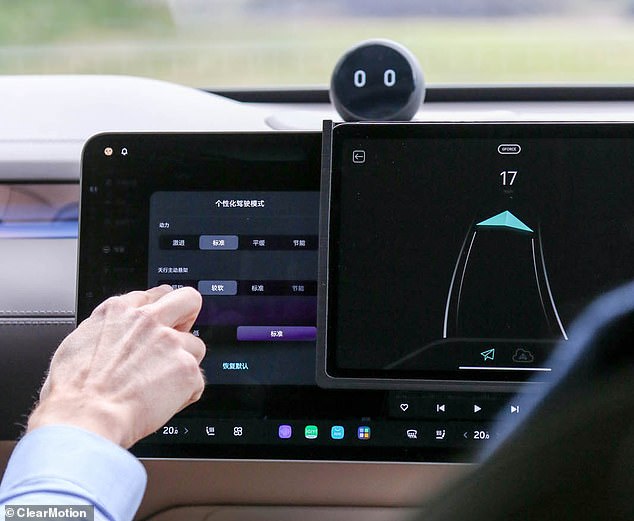
ClearMotion combines its suspension with a soon-to-be-released software called RoadMotion, which locates the car within one centimetre so the suspension can predict how it needs to react to the road ahead
‘If we had a Donald Duck car with 10-foot suspension, we could just glide over everything and it wouldn’t matter, but we only have plus or minus 10 centimetres in most cars,’ says Mr Giovanardi.
But this is where ClearMotion’s technology gets really clever.
In addition to their suspension systems, ClearMotion is also preparing to release a piece of software called RoadMotion.
RoadMotion collects GPS data and combines this with information coming from the suspension to create a map of the road which captures every bump and imperfection.
When you start to drive down that road again, your car feels the motion of the road to work out your location.
Mr Giovanardi says that this is like Shazam for the road, but instead of recognising patterns in music, it recognises patterns in potholes.
Once a road is fully mapped, RoadMotion is so accurate that it can calculate the car’s position within an accuracy of one centimetre, even driving through tunnels without GPS.
With that map of the road ahead, the car’s suspension system uses AI to plan out its movements so that any motion is reduced to an absolute minimum.
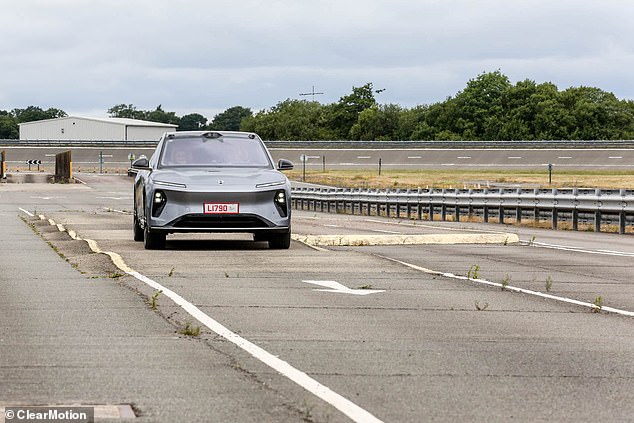
By combining RoadMotion with active suspension, even serious obstacles are barely noticeable
Mr Giovanardi says: ‘With this proactive control, you can isolate a lot more motion because, by knowing what’s coming, you can do the right thing all the time.’
ClearMotion predicts that it would take about one week for someone driving to work every day to produce a road map with 90 per cent coverage.
Likewise, they estimate that they would only need about six customers to map all 36,600 miles (58,900 km) of roads in Massachusetts.
Currently, RoadMotion is only in the prototype stages, so there aren’t many UK roads that have been fully mapped.
However, one of the few places that has been mapped extensively is the HORIBA MIRA vehicle proving ground.
Driving on this maze of slaloms, speed bumps, and vehicles can test everything from their braking distance to how they handle a section of French pavé.
But with RoadMotion turned on, I could hardly feel a thing.
Swinging around corners, the car remains almost disconcertingly level, feeling more like a rollercoaster than a race car.
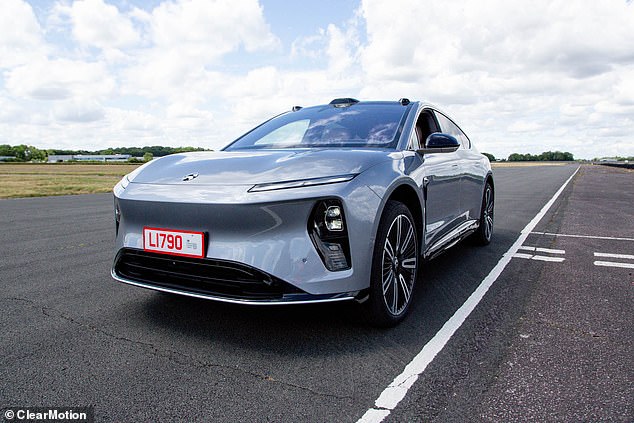
It should take a car equipped with RoadMotion around a week to map the driver’s regular commute, allowing for even smoother driving
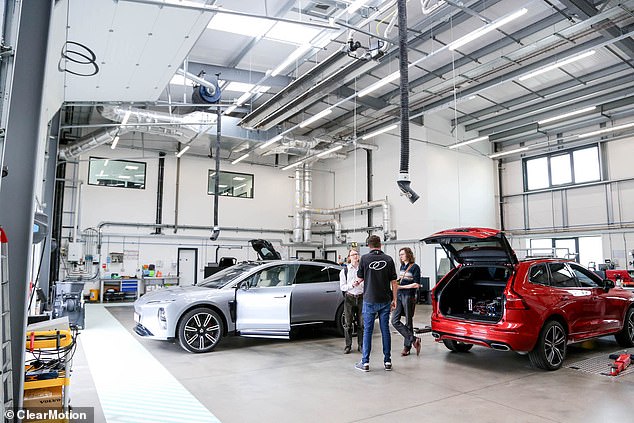
ClearMotion is currently only available in the NIO ET9, but ClearMotion CEO Christian Steinmann says it should be available on the British market by mid-2027
Even as we accelerated hard enough to pin my head to the seat, there was barely a rumble from the road.
But the most impressive moment came as we launched into a set of ‘sine-wave’ bumps designed to send unwary drivers launching into the air.
Hurtling towards the bumps at 50 miles per hour (80 kmph), I braced for impact.
Still bracing for the impending impact, I suddenly noticed the obstacles appearing in the rear-view mirror.
RoadMotion had neutralised the motion to such an extent that I hadn’t noticed a disturbance intended to get most cars airborne at 30 miles per hour (50 kmph).
Does it prevent motion sickness?
But the big question is not whether ClearMotion feels nice to drive, but rather whether it actually solves motion sickness.
Throughout the day, I did everything I could to make myself as nauseous as possible.
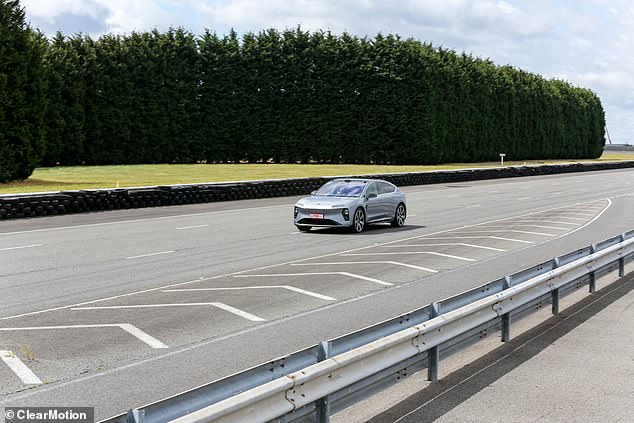
No matter how I tried, I couldn’t make myself feel motion sick in a car equipped with ClearMotion. However, Mr Steinmann says that sickness will only be ‘eliminated’ when autonomous cars give the system more control over the drive experience
I sat in the back seat, wrote emails on my phone, read a book, and even closed my eyes as I was driven around and around windy roads.
Surprisingly, while that would normally have me reaching for the sick bags, I barely felt anything more than the slightest discomfort.
However, I’m still not sure I would feel comfortable spending a long drive working from the back seat as ClearMotion envisions.
Despite how much better it was than any car I’ve ever been in, there was still room for improvement, and CEO Christian Steinmann agrees.
‘At the moment we are still in reactive mode,’ Mr Steinmann told MailOnline.
‘You still have a human in the driver’s seat, and we can only react to the demands of the driver.’
Mr Steinmann’s ultimate vision is that ClearMotion suspension would be used in autonomous vehicles, allowing humans to work or rest in peace while the car makes the ride as smooth as possible.
‘As soon as you put the human out of the loop, we know the traffic ahead and so we can calculate acceleration, deceleration and steering manoeuvres – at that moment I can really eliminate motion sickness.’
